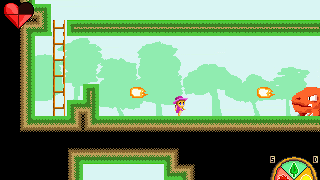Hi guys, I thought I’d make a game development post about how gameplay mechanics were tested in Frog Hop and the effect it had on the overall result of the final game.
An “Instance Test” room is a developer level that end users won’t be able to play. Its purpose is to bug test and prototype gameplay elements before they are even put into an actual level.

A simple example of the kind of stuff that you would test for. In this case, if the enemies got stunned, the collision check script didn’t run and they would phase into each other. Normally when out of stun, if they collide with the ground or an enemy they jump, which is why they hovered in this example.
It seems like a no-brainer to have a test room so that you don’t tamper with the actual levels of your game. However there are problems that I ran into when using a test room.
When it comes to making a bigger game, it becomes harder to predict what might happen since there are significantly more assets to make than just a spike and trampoline for a Game Jam game (A small game that is usually made in a short period of time).
One of the biggest problems I ran into with Frog Hop was that I would finish creating a simple enemy such as the rabbit, but I would continue exploring that enemy type, which resulted in several variants. While this might not be bad in a short term and can be fun to explore, It resulted in creating A LOT of objects and interactive assets that made it very difficult to figure out where to put it in the actual levels of Frog Hop. Especially if it’s your first game, it can sometimes be hard to plan what assets will be the most fun to put in.
In general, you want to avoid getting carried away with spending too much time on polishing and adding too many new assets. Focus on creating your game starting from level 1, play your first level, if you feel it needs an obstacle of some sort, just instance test that one asset get it to a fairly functional state and just put it in your first level. I used this approach with my first game jam game Tempora, a puzzle-platformer where you can change the seasons to affect the level’s shape as well as how you interact with things.
I’ve found this approach works well for smaller game jam games, since you can naturally just play your game from start to finish and add what it needs. Of course with a bigger game, having some experience and good planning (I’ll talk about that in another post) are key to helping you avoid spending too much time on overly polishing and adding assets.
(Of course, we are talking about video game development here, and boy do games require a lot of work and are hard to plan out!)
I’ve found the term for this is called Scope Creep, where the project size ends up becoming larger than intended, resulting in having a huge back log of assets to make and potentially resulting in burnout.
When using Instance Test Rooms…
PROS:
- Bug fixing.
- Helps avoid tampering with final level designs.
- Can discover new design concepts that could potentially work well for your project.
- Decent source for capturing bizarre gameplay moments for your social media posts.
CONS:
- Can result in Scope Creep, meaning you could get carried away with creating too many assets.
- Can get caught up with polishing just one gameplay element and lose track of the overall layout of your game.
- Can get “lost”, where you become attached to the test room and don’t actually design levels that would properly implement your asset.
In conclusion, from my own experience, instance test rooms in general are very useful for testing and polishing your planned asset. While they are great for this purpose, as well as for exploring game concepts, they should be used with caution as the project can run the risk of scope creep! Instance test rooms are important to have, just…don’t get TOO attached to them!
Hope you enjoyed reading,
-Brandon


